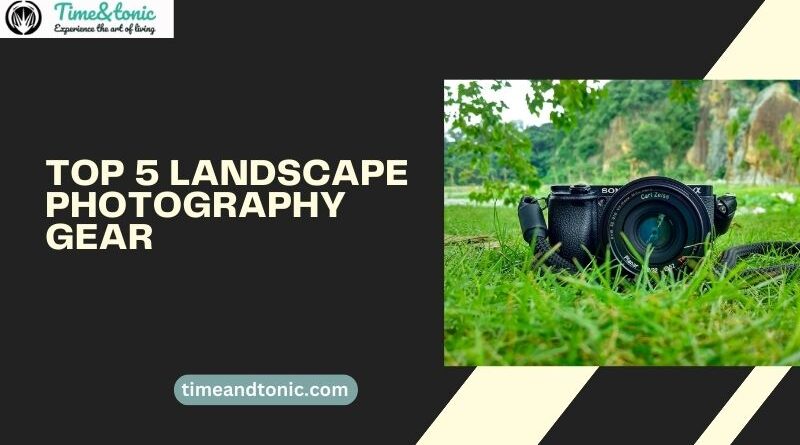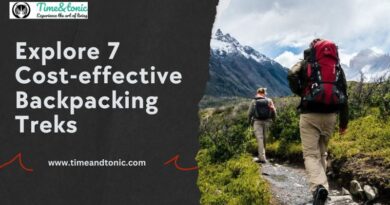Top 5 Landscape Photography Gear
When it comes to capturing the beauty of the great outdoors, having the right photography gear can make all the difference. Whether you’re an aspiring landscape photographer or a seasoned pro, having top-notch equipment is essential to take your landscape photography to the next level.
There is an abundance of cameras, an array of lenses, and a multitude of accessories to choose from, and making the right equipment choices can significantly impact your photography.
Fortunately, I’ve accumulated years of experience in capturing landscapes, so I understand the dilemmas you might be facing. I can discern the gear that truly matters and help you avoid unnecessary items. In this article, I’ll share the five most essential pieces of equipment with you.
As you go through this list, take a moment to consider, “What might I be overlooking?” If feasible, consider perusing through your preferred (online) camera store to complete your hardware collection.
Let’s dive right in.
Essential Landscape Photography Gear
This section covers essential five landscape photography gear for your next travel journey.
1. Camera

Every landscape photographer must have a camera, but it’s crucial not to hastily choose the first or cheapest model you come across. The best cameras for landscape photography typically feature a large sensor (APS-C can suffice, but a full frame is preferable), a reasonably high megapixel count, and an ergonomic design. Opting for a camera with a fully articulating or tilting screen can also be beneficial, allowing you to capture low-angle shots without having to get down on the ground.
Additionally, consider the importance of weather-sealing. As a landscape photographer, you’ll inevitably find yourself working in challenging conditions like heavy snow. Since adverse weather often leads to stunning photos, you won’t want to cease shooting. However, without proper protection from the elements, your camera’s electronics could be at risk.
To address this, invest in a camera made from durable materials, preferably one with a metal alloy body rather than a plasticky, entry-level option.
Furthermore, think about acquiring a high-quality rain cover for your camera and lens. I don’t recommend opting for the cheap, flimsy, clear plastic covers made from recycled sandwich bags, as they tear easily and struggle to stay in place during windy conditions. Instead, invest in a heavy-duty cover that offers long-lasting protection. It may not be overly expensive, and it will enable you to keep shooting in challenging scenarios.
Wide-Angle Lens
Lenses mark the exciting beginning of your photography journey and the point where your wallet takes a hit.
You see, lenses are the single most crucial component of landscape photography equipment that you can invest in. Even if you have the finest camera, tripod, backpack, memory cards, and an array of accessories at your disposal, the absence of quality glass will hinder your ability to capture sharp images.
Personally, I lean toward using prime lenses rather than zoom lenses, and here’s why: I aim to immerse myself as deeply as possible in the scene. Zoom lenses sometimes make me a bit complacent, and I find myself taking shots without fully exploring the scene. There’s simply no substitute for repositioning yourself and viewing the composition with your own eyes, rather than relying solely on the viewfinder. This unique perspective is lost when you zoom in rather than physically moving around and contemplating the scene.
However, the choice of a landscape lens can be quite subjective. I’m acquainted with numerous photographers who prefer using zoom lenses, and that’s perfectly fine. Most of the time, the best equipment for you is the one you feel most comfortable with.
Here’s my advice: Before committing to purchasing any lens, whether it’s a prime or a zoom, consider renting it first. You can’t truly gauge how a lens will perform in various situations until you’ve used it. While user reviews and recommendations are valuable, your individual style and preferences will always be distinctive.
Quick Link: 7 Incredible Ways To Spend A Day for Mental Health
Tripod

When it comes to landscape photography, one piece of equipment you should never compromise on is a tripod. In fact, alongside a good backpack, a tripod is an accessory I strongly advise you to invest generously in.
Why, you might ask? Well, a tripod serves the crucial purpose of keeping your camera steady, even in challenging terrain like muddy, rocky, or sandy wilderness. It acts as a safeguard against unexpected camera tumbles. Achieving this level of stability requires a tripod with an ultra-solid construction, and such quality often comes with a price tag.
Moreover, a flimsy tripod can potentially lead to costly repair bills. A strong gust of wind is all it takes to topple an unstable tripod. Imagine having a high-quality camera and lens mounted on a low-end tripod – it’s akin to fitting an elite sports car with old, worn-out tires. The vehicle won’t perform as it should, and it poses a risk to the entire setup.
A good tripod is an investment that will outlast the rest of your gear. In my experience, spending a bit more money upfront pays off in the long run, ensuring a stable and secure setup.
For excellent landscape tripods, consider reputable brands like Really Right Stuff, Manfrotto, Gitzo, and Feisol. I strongly recommend giving preference to carbon fiber tripods over aluminum ones. They are not only lightweight but also exceptionally sturdy.
Filters
In landscape photography, certain filters are almost as indispensable as high-quality lenses. I’ll provide a brief overview of a few essential filters that I always carry with me:
Circular Polarizer
A circular polarizing filter is a valuable tool for reducing harsh reflections from shiny surfaces, like wet rocks or waxy leaves. It’s particularly handy when capturing scenes with fall foliage or water. Using a circular polarizer is straightforward – you mount it on your lens and adjust the front element until the unwanted glare disappears. Keep in mind that using a polarizer will result in some light loss, but this can be managed easily with a sturdy tripod. Additionally, it can darken the sky, enhancing its blue color. While personal preferences may vary, I find myself using a polarizer frequently in daylight shooting situations and recommend having one for each of your primary landscape lenses.
Neutral-Density (ND) Filter
An ND filter acts like sunglasses for your lens by reducing the amount of light that reaches the camera’s sensor, thus slowing down the exposure. For landscape photography, I suggest carrying a 2-stop, 3-stop, and 10-stop ND filter. However, if you’re just starting out, beginning with a 10-stop filter may be a good choice. A 10-stop filter can help create silky-smooth water in long-exposure waterscape shots and extend cloud movements (subject to lighting conditions and wind speeds).
Graduated Neutral-Density (GND)
Filter GND filters are similar to ND filters, but they darken only the upper part of the filter. These filters are particularly useful during sunrise and sunset when the sky is brighter than the foreground. By using a GND filter, you can balance the exposure, darkening the sky while maintaining brightness in the foreground. This allows you to capture scenes with high dynamic ranges without losing detail. It’s worth noting that good-quality GND filters can be expensive, and some photographers prefer HDR techniques instead.
You May Also Like: Top 10 Christopher Nolan Movies That Redefined Cinema
Clear or UV Filter

To safeguard my lenses from wear and tear, I always attach a clear or UV filter to the front of each lens. While these filters do not enhance image quality, they provide excellent protection for the lens’s front element, guarding it against dirt and dust. Additionally, a clear or UV filter can save your lens in the unfortunate event of an accidental collision. Be cautious of low-quality clear filters; it’s advisable to choose reputable brands like Hoya or B+W for superior protection.
Investing in these essential filters can significantly elevate your landscape photography, enabling you to overcome various lighting and environmental challenges while protecting your valuable camera gear.
Backpack or Bag
In landscape photography, having a reliable backpack is an absolute necessity, and it’s not an area where you want to cut corners on quality. Quality aligns with what you receive, and it’s crucial to opt for a sturdy, water-resistant backpack with reinforced padding. The primary objective here is to safeguard your equipment and ensure your comfort. While protection and comfort may not appear to be immediate concerns, just wait until you spend a day trekking through the woods in the pouring rain!
Therefore, do yourself a favor and make an investment in a top-tier backpack. It will take care of your camera gear and lenses while serving you well for many years. When evaluating different options, pay close attention to the bag’s size and how well it accommodates your specific cameras, lenses, and accessories.
Conclusion
In the world of landscape photography, the right gear can make all the difference in capturing stunning images of the natural world. While there’s an abundance of equipment available, focusing on the essentials can help you create incredible photographs without breaking the bank. Here are the top five landscape photography gear items every aspiring landscape photographer should consider:
- Camera: Invest in a camera with a large sensor, high megapixel count, and weather-sealing to capture the beauty of nature effectively.
- Lenses: Choose lenses that suit your style, whether prime or zoom and consider renting before buying to find the perfect match.
- Tripod: Don’t compromise on stability; invest in a durable tripod to keep your camera steady in challenging conditions.
- Filters: Essential filters include circular polarizers, neutral-density filters, and graduated neutral-density filters, which enhance your creative control over landscapes.
- Backpack: A high-quality, water-resistant backpack with reinforced padding ensures your gear’s safety and comfort during outdoor photography adventures.
By prioritizing these essential gear items, you can elevate your landscape photography and capture the beauty of the natural world in all its glory.
FAQs
While full-frame cameras offer advantages in image quality, APS-C cameras can also produce excellent landscape photos. Choose a camera with good dynamic range and weather-sealing for outdoor shooting.
The choice between prime and zoom lenses is a matter of personal preference. Prime lenses often encourage more deliberate composition, while zoom lenses offer versatility. Test both to see which suits your style.
You don’t necessarily need all the recommended filters, but each serves a specific purpose. A circular polarizer is versatile and great for reducing reflections. Graduated neutral-density filters help balance bright skies with darker foregrounds, and neutral-density filters enable long-exposure shots.




